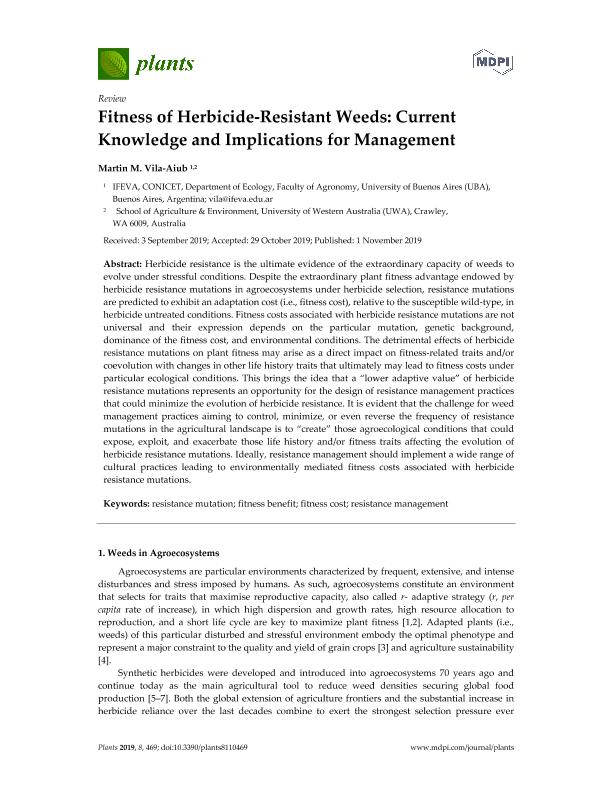Artículo
Fitness of herbicide-resistant weeds: Current knowledge and implications for management
Fecha de publicación:
11/2019
Editorial:
Multidisciplinary Digital Publishing Institute
Revista:
Plants
e-ISSN:
2223-7747
Idioma:
Inglés
Tipo de recurso:
Artículo publicado
Clasificación temática:
Resumen
Herbicide resistance is the ultimate evidence of the extraordinary capacity of weeds to evolve under stressful conditions. Despite the extraordinary plant fitness advantage endowed by herbicide resistance mutations in agroecosystems under herbicide selection, resistance mutations are predicted to exhibit an adaptation cost (i.e., fitness cost), relative to the susceptible wild-type, in herbicide untreated conditions. Fitness costs associated with herbicide resistance mutations are not universal and their expression depends on the particular mutation, genetic background, dominance of the fitness cost, and environmental conditions. The detrimental effects of herbicide resistance mutations on plant fitness may arise as a direct impact on fitness-related traits and/or coevolution with changes in other life history traits that ultimately may lead to fitness costs under particular ecological conditions. This brings the idea that a “lower adaptive value” of herbicide resistance mutations represents an opportunity for the design of resistance management practices that could minimize the evolution of herbicide resistance. It is evident that the challenge for weed management practices aiming to control, minimize, or even reverse the frequency of resistance mutations in the agricultural landscape is to “create” those agroecological conditions that could expose, exploit, and exacerbate those life history and/or fitness traits affecting the evolution of herbicide resistance mutations. Ideally, resistance management should implement a wide range of cultural practices leading to environmentally mediated fitness costs associated with herbicide resistance mutations.
Palabras clave:
FITNESS BENEFIT
,
FITNESS COST
,
RESISTANCE MANAGEMENT
,
RESISTANCE MUTATION
Archivos asociados
Licencia
Identificadores
Colecciones
Articulos(IFEVA)
Articulos de INST.D/INV.FISIOLOGICAS Y ECO.VINCULADAS A L/AGRIC
Articulos de INST.D/INV.FISIOLOGICAS Y ECO.VINCULADAS A L/AGRIC
Citación
Vila Aiub, Martin Miguel; Fitness of herbicide-resistant weeds: Current knowledge and implications for management; Multidisciplinary Digital Publishing Institute; Plants; 8; 11; 11-2019; 1-12
Compartir
Altmétricas




